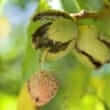Background
- Black walnut (Juglans nigra) is a large tree known for its high-quality wood and edible nut which is commonly used as a food ingredient.
- The U.S. Food and Drug Administration (FDA) announced a health claim stating that eating 1.5 ounces per day of walnuts as part of a diet low in fat may reduce the risk of heart disease.
- Black walnut has been shown to contain chemicals called tannins which may help with irritation and may improve tissue firmness. Traditionally, it has been used to relieve constipation and diarrhea.
References
Natural Standard developed the above evidence-based information based on a thorough systematic review of the available scientific articles. For comprehensive information about alternative and complementary therapies on the professional level, go to . Selected references are listed below.
- Amarowicz, R, Dykes, GA, and Pegg, RB. Antibacterial activity of tannin constituents from Phaseolus vulgaris, Fagoypyrum esculentum, Corylus avellana and Juglans nigra. Fitoterapia 2008;79(3):217-219.
View Abstract - Choi, HR, Choi, JS, Han, YN, et al. Peroxynitrite scavenging activity of herb extracts. Phytother Res. 2002;16(4):364-367.
View Abstract - Belknap, JK, Giguere, S, Pettigrew, A, et al. Lamellar pro-inflammatory cytokine expression patterns in laminitis at the developmental stage and at the onset of lameness: innate vs. adaptive immune response. Equine Vet J 2007;39(1):42-47.
View Abstract - Eaton, SA, Allen, D, Eades, SC, et al. Digital Starling forces and hemodynamics during early laminitis induced by an aqueous extract of black walnut (Juglans nigra) in horses. Am J Vet Res. 1995;56(10):1338-1344.
View Abstract - Fontaine, GL, Belknap, JK, Allen, D, et al. Expression of interleukin-1beta in the digital laminae of horses in the prodromal stage of experimentally induced laminitis. Am J Vet Res. 2001;62(5):714-720.
View Abstract - Galey, FD, Beasley, VR, Schaeffer, D, et al. Effect of an aqueous extract of black walnut (Juglans nigra) on isolated equine digital vessels. Am J Vet Res. 1990;51(1):83-88.
View Abstract - Hurley, DJ, Parks, RJ, Reber, AJ, et al. Dynamic changes in circulating leukocytes during the induction of equine laminitis with black walnut extract. Vet Immunol Immunopathol. 4-15-2006;110(3-4):195-206.
View Abstract - Inbaraj, JJ and Chignell, CF. Cytotoxic action of juglone and plumbagin: a mechanistic study using HaCaT keratinocytes. Chem Res Toxicol. 2004;17(1):55-62.
View Abstract - Loftus, JP, Belknap, JK, and Black, SJ. Matrix metalloproteinase-9 in laminae of black walnut extract treated horses correlates with neutrophil abundance. Vet Immunol Immunopathol. 10-15-2006;113(3-4):267-276.
View Abstract - McConnico, RS, Stokes, AM, Eades, SC, et al. Investigation of the effect of black walnut extract on in vitro ion transport and structure of equine colonic mucosa. Am J Vet Res. 2005;66(3):443-449.
View Abstract - Moodley, R, Kindness, A, and Jonnalagadda, SB. Elemental composition and chemical characteristics of five edible nuts (almond, Brazil, pecan, macadamia and walnut) consumed in Southern Africa. J Environ Sci Health B 2007;42(5):585-591.
View Abstract - Qasem, JR. Weed Allelopathy, Its Ecological Impacts and Future Prospects: A Review. Journal of Crop Production. 2001;4(2):43-119.
- Riggs, LM, Franck, T, Moore, JN, et al. Neutrophil myeloperoxidase measurements in plasma, laminar tissue, and skin of horses given black walnut extract. Am J Vet Res. 2007;68(1):81-86.
View Abstract - Roux, KH, Teuber, SS, and Sathe, SK. Tree nut allergens. Int Arch.Allergy Immunol. 2003;131(4):234-244.
View Abstract - von Kiparski, G. R., Lee, L. S., and Gillespie, A. R. Occurrence and fate of the phytotoxin juglone in alley soils under black walnut trees. J Environ Qual. 2007;36(3):709-717.
View Abstract







